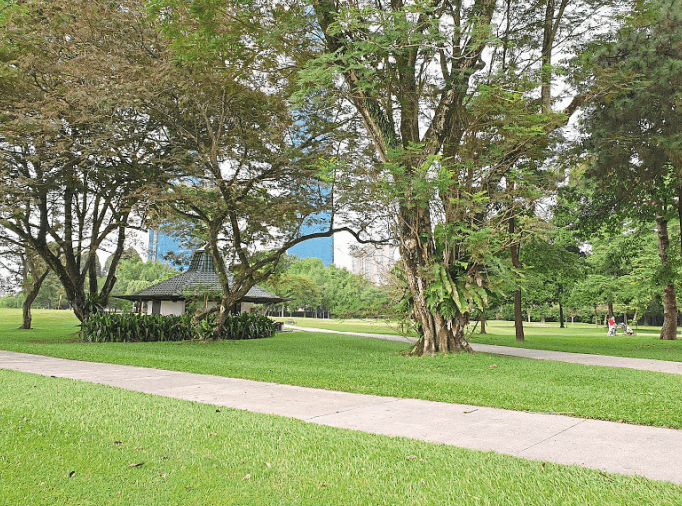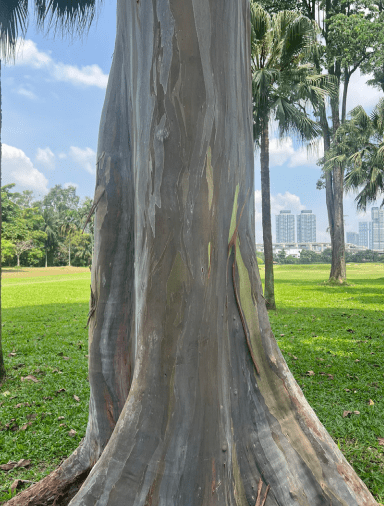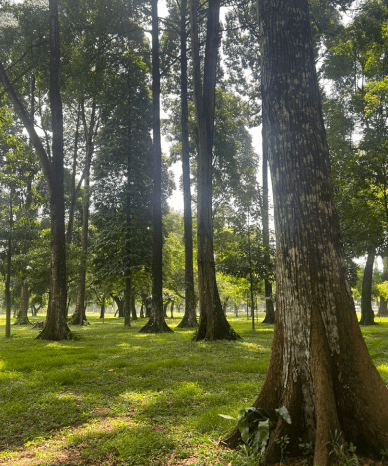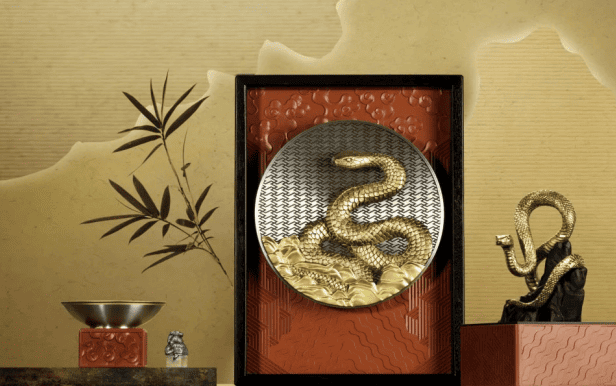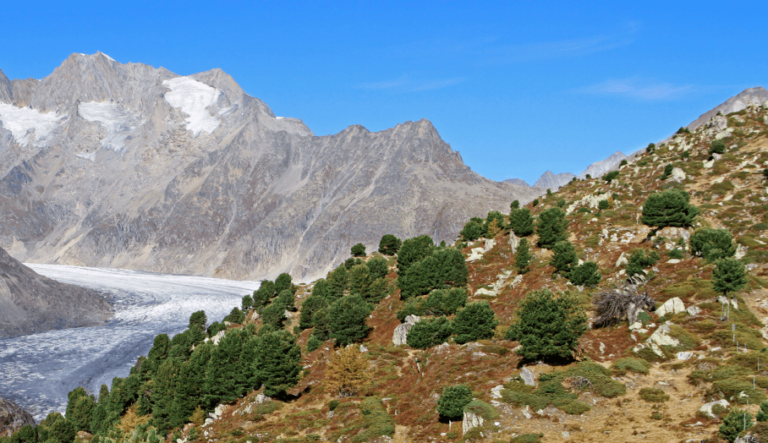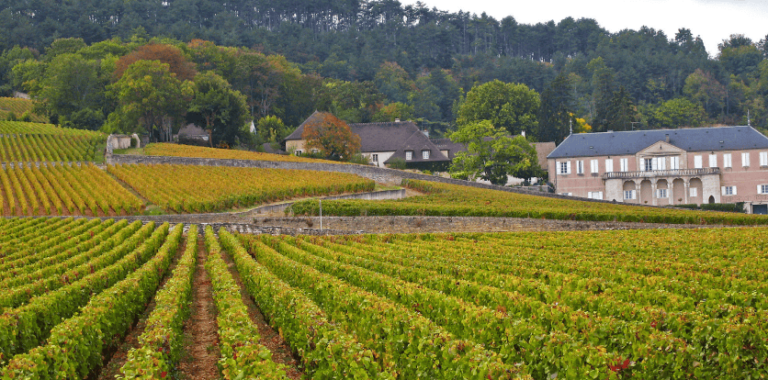The appealing 10th Old Course will serve as the forest tee-off point for the course on August 14, 2024. Come join us for an experiential nature tour.
Out of the ten tree species that will be covered, two were already seen on the previous nature walk. There are eight stations in total. Presenting mature species that were seen on the walk should be done at this point. Compared to previous nature walks, this one will be more adventurous. exploring the RSGC’s tiny forest and submerging oneself in the wet rainforest. Furthermore, we remind participants to be mindful of the numerous insects, mosquitoes, and the wet region.
Each of the stations, as follows:
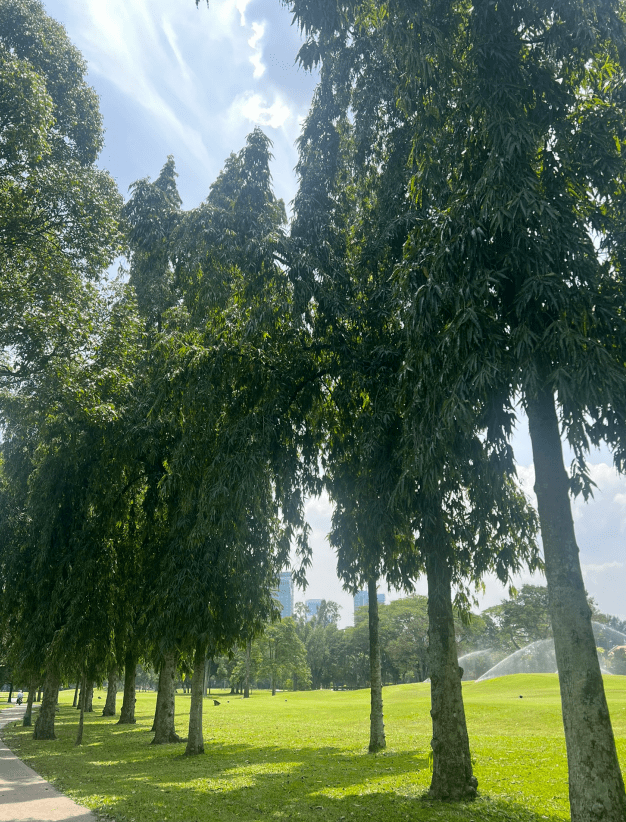 A row of M. longifolia var pendula planted as a screen
A row of M. longifolia var pendula planted as a screen
Station 1 – Ashoka Tree as the symbol of love
Monoon longifolia is a small to medium sized compact evergreen tree that can grow up to 18 m high. It is native to India and Sri Lanka. It comes in two forms, one in spreading branches with almost perpendicular branches arising from the main trunk and the other one with pendulous branches forming a conical and tightly columnar form which is believed to be cultivar of the spreading type. The trunk is straight, cylindrical with cracking dark grey bark. The wood is yellowish brown.
The leaves are simple, alternate, long and lanceolate, tapering gradually to a point. The leaves are shiny and dark green above and yellowish underneath. The leaves are long pointed and shiny dark green above and yellowish underneath.
Flowers are in bunches of inconspicuous pale green which last 2-3 weeks, borne on the older parts of twigs. Flowers have no fragrance. It produces smooth shiny fruit in clusters of 5-13, which ripen from yellowish then reddish and finally black in colour. The seeds are loved by birds and bats. This species is suitable to be planted as avenue or as a screen. It is also suitable to be planted in restricted areas as it does not spread or form branches.
A row of M. longifolia var pendula planted as a screen. It can be planted as a row or in restricted areas due to its columnar shape. The trunk is straight cylindrical with cracking dark grey bark.
The tree is considered to be very spiritual and is often planted around Buddhist and Hindu temples. It is said that Buddha was born under this attractive tree. The common name, Asoka, means ‘sorrowless’ or ‘remover of sorrow’ in Sanskrit. The Ashoka tree is a symbol of love.
Multi-coloured bark featuring hues of lavender, blue, green, orange and red
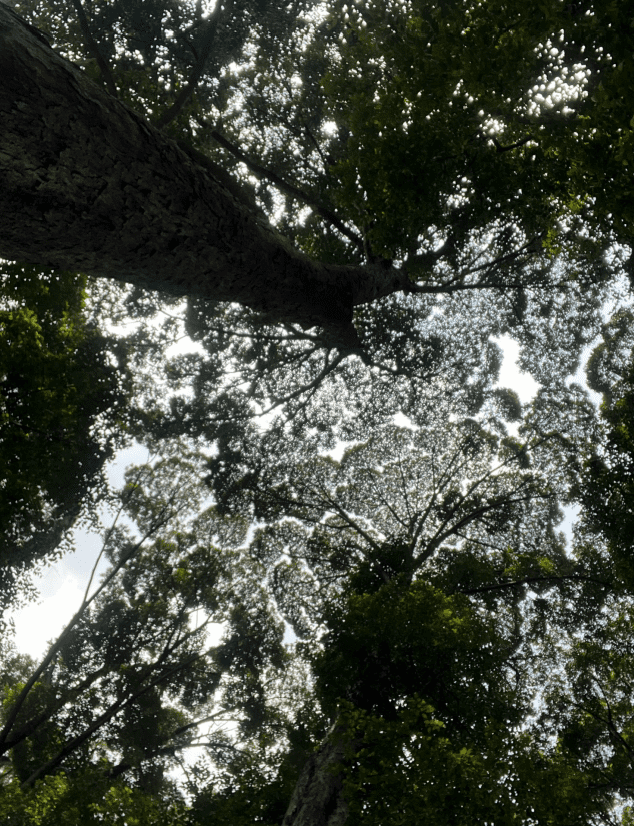 Aromatic Kapur tree known for crown shyness
Aromatic Kapur tree known for crown shyness
Station 2 – Fragrant Cempaka flowers
White Champaca is a medium sized evergreen tree which can grow up to 25m tall. It has an upright habit with cylindrical to conical crown. The leaves are lime green in colour. It is a flowering tree widely cultivated in Southeast Asia. It is considered to be a hybrid of Magnolia champaca and Magnolia montana. This species exhibits fairly fast growth under local conditions. It has a smooth trunk and silvery grey bark. It is commonly cultivated for its fragrant flowers and is popularly planted in parks, gardens and roadsides. The fragrant white flowers are adorned for hair and to make garlands. An essential oil is extracted from the flowers. The bitter alkaloids in the tissues of the tree makes it insect resistant and the wood is used for carvings, panelling, doors and furniture.
This species grows well under full sunshine and requires regular watering during the establishment stage. It is suitable to be planted in parks particularly in sensory gardens.
Dense Merawan tree cluster resembles a broccoli like crown shaped
Station 3 – Aromatic Kapur Tree: Known for crown shyness
Dryobalanops aromatic or locally known as Kapur is known to grow up to 45 m in its natural habitat (mixed dipterocarp forests). It has buttress roots and resin which is known as dammar. The specific epithet ‘aromatica’ is derived from Latin (aromaticus) which refers to the smell of the dammar (resin). All parts of the tree produce camphor-like-fragrance. The last nature walk shows the tree in a row arrangement. As for this walk, the setting up of the forest would show the crown shyness of the tree clearly.
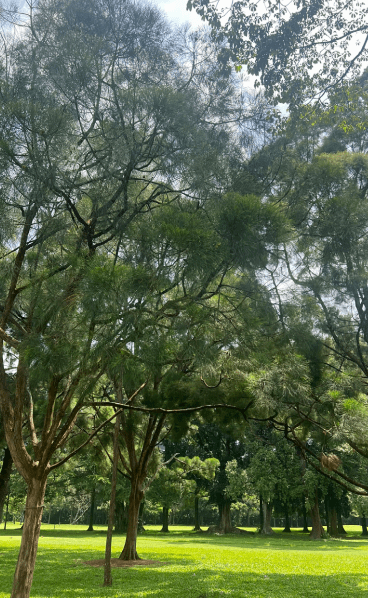 G. rumphianum are neddle-like leaf
G. rumphianum are neddle-like leaf
Station 4 – Dense Merawan Tree Cluster
The self-pruning Merawan had been talked about from previous Nature walk event. The matured, tall and thin Merawan were presented in a dense group of the small forest. The upright tall and thin shapeof every Merawan tree creates a uniformity of landscape greenery background. A cluster round canopies looking like broccoli shaped tree.
Swietenia macrophylla is a deciduous large hardwood tree growing to 30 m tall. It is fast growing and relatively pest free and can be grown in a variety of soil types. It has a dense dark green round to oblong crown when young and becomes more open and irregular when older. It has a buttressed trunk with dark grey scaly bark which has a sweet odour. The wood is reddish, pinkish or yellowish when fresh and turning deep red or brown with age.
Mahogany has large leaves up to 45 cm long. The leaves are simple pinnate compound, – the young leaves are pink and eventually wither orange-brown to scarlet. The tree bears heavy brown fruit and small white flowers. The fruit is called ‘sky-fruit’ because of its upward growth towards the sky. Each fruit contains many winged seeds which are used as a natural remedy for diabetes and high blood pressure. The tree is planted as a shade tree in large open areas. The timber is highly valued as it is dense, close—grained and a rich red-brown colour. The wood is used for fine furniture, cabinets, musical instruments and interior panelling. The trunk is straight, cylindrical, with a buttressed base.
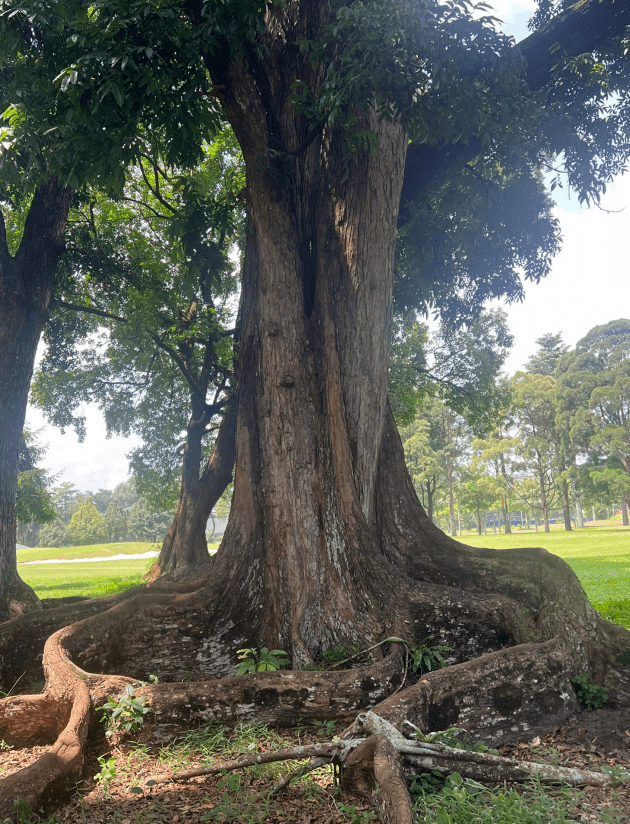 Mahogany tree notable for its unique buttress roots
Mahogany tree notable for its unique buttress roots
Station 6 – Rhu Trees: Various lush types
Gymnostoma nobile known as Bornean Rhu is an evergreen tree which is native to Sarawak. This species can grow up to 40m tall and has a conical shaped crown when it is young, and irregular once matured. It is distributed in Borneo and the Philippines, and mostly found in the Kerangas or peat swamp forests up to 1,300m altitude. It has a graceful spreading foliage. The leaves of G. nobile are scale-like in whorls. The young flowers exist in small cone-like structure while the female ones develop into a more rounded cone. Its bark is brownish and fissured. This tree grows better in sandy areas (like beaches) to rocky soils. The cluster of matured trees resemble conifer—like foliage.
This species is commonly planted at roadsides and in parks. The timber is said to be used for construction and fuel.
Another type of Rhu, is called Weeping Rhu. Gymnostoma rumphianum is an angiosperm found naturally in Sulawesi, the Moluccas and the Philippines. This tree is a slow-growing evergreen tree which grows up to 20m tall.
The twigs of G. rumphianum are needle-like with many lateral branches. This gives the soft bushy appearance. The leaves are tiny, scale like and wrap around the needle-like twigs. The flowers are small and occurs at the terminal. The fruits look like pine cones, roundish and woody of 3cm in diameter.
This species requires full sun and a well-drained and acidic soil. Gymnostoma rumphianum has a symbiotic relationship with certain bacteria. These bacteria form nodules on the roots and fix atmospheric nitrogen. Some of this nitrogen is utilized by the growing plant but some can also be used by other plants growing nearby. It is suitable to be planted in the parks and parking lots.
Station 7 – Rainbow Eucalyptus: Artistic trunk
Eucalyptus deglupta is native to the Philippines, Indonesia and Papua New Guinea. This is a fast growing species which typically reaches a height of 60-75 m with the trunk up to 240 cm in diameter and with buttresses up to 3-4m high.
It is a medium to large sized evergreen tree that has attractive bark patterns and colour. This species has smooth, orange tinted bark that sheds in strips revealing streaks of lavender, blue pale green, red, orange, grey and purplish brown. This characteristic makes this species very attractive to be planted in parks or as avenue trees.
The leaves ovate to ovatelanceolate, opposite, acuminate and are held almost horizontal on branches. The flowers are white to pale yellow, arranged in 3-7 umbels in terminal or axillary panicles. The woody pods are brown, hemispherical capsule about 3-5 mm long and wide with three or four valves extended beyond the rim of the fruit. Each cell contains between 3-12 small brown seeds with a small wing. This species can be propagated by cuttings.
Station 8 – Evergreen Pulai Varieties.
The common Pulai is known as Alstonia angustiloba. The genus ‘Alstonia’ named after a Scottish naturalist Dr. Charles Alston (1685- 1760), where the specific epithet ‘angustiloba’ means having narrow lobes, referring to the narrow calyx lobes of the flower. Pulai is a large tree which can grow up to 45 m and diameter from 60-100cm. The trunk is normally deeply fluted at the base and has buttress roots. The bark is greyish or brownish.
Pulai has pagoda-shaped crown. It has simple leaves which are arranged from 4-9 in whorls. It has creamy white fragrant flowers and always in clusters of 3-8 at the end of twigs The pods are smooth and split open to disperse the seeds. The fruits are a pair of long cylindrical pods 20-30 cm long and about 3mm wide. Alstonia angustiloba exudes milky latex which contains alkaloids when wounded. The latex is used in medicine to heal boils.
The bark is smooth when young becoming slightly cracked with age.
Pulai wood is not recommended for structural purposes. It is suitable for making pencils, boxes, coffins, drawing boards, picture frames, matches and handicrafts.
Another Pulai is known as Indian Pulai. Alstonia scholaris is an evergreen tree which grows up to 50m tall. The species epithet ‘scholaris’ refers to the tree’s wood which was traditionally used to make slates for school children. This species has a pagodashaped crown quite similar to A. angustiloba. The bark contains alkaloids that have been used for the treatment of malaria, diarrhoea and dysentery. The leaves are arranged in whorls of 4-8 leaflets, occasionally 9. The leaves are glossy dark green above and paler green below. The flowers are creamywhite to pale yellow produced in inflorescences at the end of branches. The flowers produce strong fragrance, with the scent of burnt. Fruits are produced in pairs and are pendulous with 20-40cm long. It turns from green to brown when ripe.
The wood of A. scholaris is very light. The wood is known to be used for making coffins, household utensils, corks, etc.
Alstonia scholaris is a hardy and fast growing tree. The tree has an attractive pagoda crown and is widely used in landscaping.
Purpose of exploring the pocket forest during the walk
To compare different species of trees planted in the same genus at the Royal Selangor Golf Club and to understand the characteristics of each tree planted in terms of its use and beauty. Depending on how they are planted and what species was put in the back, the trees may have historical symbolic meaning

